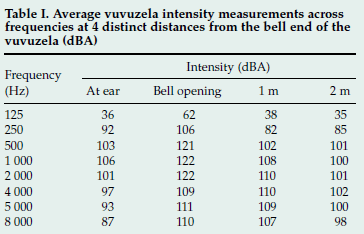Serviços Personalizados
Artigo
Indicadores
Links relacionados
-
 Citado por Google
Citado por Google -
 Similares em Google
Similares em Google
Compartilhar
SAMJ: South African Medical Journal
versão On-line ISSN 2078-5135
versão impressa ISSN 0256-9574
SAMJ, S. Afr. med. j. vol.100 no.4 Pretoria Abr. 2010
CORRESPONDENCE
Vuvuzela sound measurements
To the Editor: Our recent paper in the SAMJ1 reported the maximum output levels of a vuvuzela at various distances from the horn. In response to enquiries, we provide additional information on the method and results reported in the earlier paper.
One commercial vuvuzela was used in the recording of sound levels at 4 different positions: (i) at the ear of the person blowing the vuvuzela; (ii) at the bell end; (iii) 1 m from the bell end; and (iv) 2 m from the bell end. All measurements were made approximately 1.6 m from the ground, in an openair setting. Sound levels were measured twice at a single instance while the vuvuzela was being blown by one of the investigators. Measurements were made using a calibrated Type 1 Larson Davis SLM 824 sound level meter with a 2559 normal sensitivity microphone fitted with a manufacturersupplied windscreen (WS001). Measurements were made using the fast response time option, which corresponds to a time constant of 0.125 s that is intended to approximate the time constant of human hearing.2
The initial report1provided the maximum instantaneous A-weighted sound pressure level (Lmax Fast [dBA]) averaged for 2 recordings during single vuvuzela blasts at 4 distances from the bell of the vuvuzela. This method is in agreement with the recommendation by the World Health Organization2 for measuring individual sound events. A-weighting was used for all measurements to compensate for the non-linear sensitivity of the human ear, which is differentially sensitive to sound across the frequency spectrum (least sensitive at very high and very low frequencies). A breakdown of the average intensities at individual frequencies across the frequency spectrum is provided in Table I. A characteristically flat frequency spectrum was evident between 250 and 8 000 Hz. The average intensity difference between the individual frequency measurements (Table I) of the 2 recordings at each of the 4 respective distances from the bell of the vuvuzela was 0.6 dB (±3.2 dB standard deviation).

These measures provide an indication of the sound levels and frequency spectrum of a typical vuvuzela. There are now numerous types of vuvuzela made by several manufacturers, which may all produce varying intensity and frequency outputs. In addition to these variables, individuals blowing a vuvuzela will produce varying intensities depending on their technique and the pressure exerted. Also, the sound level produced by multiple individuals simultaneously blowing vuvuzelas within a limited space cannot be predicted from these data.
De Wet Swanepoel
Department of Communication Pathology
University of Pretoria, and Callier Center for Communication Disorders
University of Texas
Dallas, USA
dewet.swanepoel@up.ac.za
James W Hall III
Department of Communication Pathology
University of Pretoria, and Department of Communicative Disorders
University of Florida
Gainesville, Fla, USA
Dirk Koekemoer
Research and Development Department
GeoAxon
Pretoria
1. Swanepoel D, Hall JW III, Koekemoer D. Vuvuzela - good for your team, bad for your ears. S Afr Med J 2010; 100: 99-100. [ Links ]
2. Berglund B, Lindvall T, Schwela DH, Goh KT, eds. Guidelines for Community Noise. Technical Report. Geneva: World Health Organization, 1999. [ Links ]














